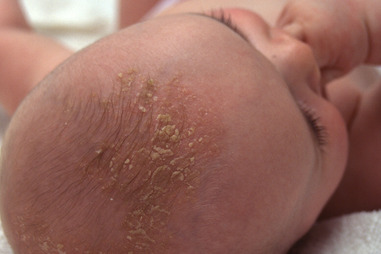Cradle Cap Causes, Symptoms, Diagnosis and Treatment

What Is Cradle Cap?
Cradle cap, also known as infantile or neonatal seborrhoeic dermatitis, crusta lactea, milk crust, honeycomb disease, is a yellowish, patchy, greasy, scaly and crusty skin rash that develops on the scalp of recently born babies.
It is usually not itchy and does not bother the baby. Similar symptoms in older children are more likely to be dandruff than cradle cap.
The rash is most often occurs around the ear, the eyebrows or the eyelids. Most babies have a mild version of cradle cap. A severe version is highly rare. It generally begins when the baby is three months old and usually disappear with time.
However, if it persists, it is recommended to see a doctor who will then treat it via medicated lotion or shampoo etc.
Causes Of Cradle Cap:
The definite cause of cradle cap is not known.
However, it is known that it is not caused by allergy, bacterial infection, or poor hygiene. Neither is it contagious.
It seems to be caused by fungal infection or over reactive sebaceous glands. Some babies are thought to retain some of their mother’s hormones in their bodies for several weeks or months after their birth. These hormones may make the baby’s glands produce more sebum.
Another plausible theory suggests that it is caused by a common manifestation of biotin insufficiency. This may be due to the role of biotin on fatty acid biosynthesis.
Symptoms Of Cradle Cap:
Signs and symptoms of cradle cap include:
- Patchy scaling or thick crusts on the scalp
- Oily or dry skin covered with flaky white or yellow scales
- Skin flakes
- Possibly mild redness
- Affects eyelids, ears, nose or groin
Diagnosis Of Cradle Cap:
There is no specific test which help in diagnosing cradle cap.
A dermatologist is likely to diagnose cradle cap via simple physical examination of the symptoms and by taking a medical history.
In very rare cases, a skin biopsy may be done if the doctor suspects some other cause for the symptoms exhibited.
Treatment Of Cradle Cap:
Usually, cradle cap disappears n its own and do not require any treatment,
In case of severe cradle cap, or if symptoms persist, treatment may be sought.
A dermatologist is likely to prescribe medicated shampoo or a lotion in order to treat cradle cap.
Related Articles:
Bursitis Causes, Symptoms, Diagnosis and Treatment
Folliculitis Causes, Symptoms, Diagnosis and Treatment
Carcinoid Syndrome Causes, Symptoms, Diagnosis and Treatment
Buerger’s Disease Causes, Symptoms, Diagnosis and Treatment
Shingles Symptoms, Causes, Diagnosis and Treatment
Chilblains Causes, Symptoms, Diagnosis and Treatment
Contact Dermatitis Causes, Symptoms, Diagnosis and Treatment
Cold Urticaria Causes, Symptoms, Diagnosis and Treatment
Henoch Schonlein Purpura (HSP) Causes, Symptoms, Diagnosis and Treatment
Soft Tissue Sarcoma Causes, Symptoms, Diagnosis and Treatment
Pilonidal Cyst Causes, Symptoms, Diagnosis and Treatment
Stevens-Johnson Syndrome Causes, Symptoms, Diagnosis and Treatment
By : Natural Health News




